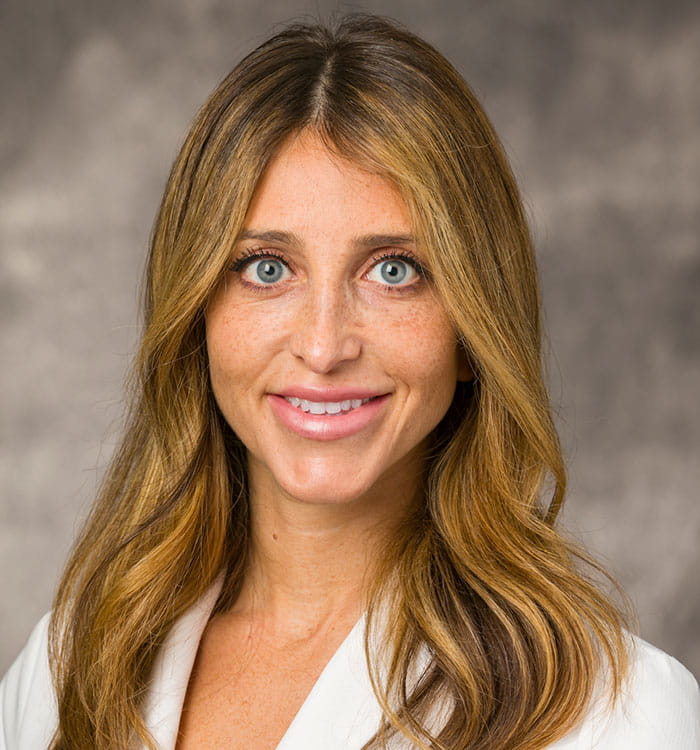Deep Brain Stimulation for OCD
June 11, 2019
Innovative therapies control debilitating conditions
Innovations in Neurology & Neurosurgery | Summer 2019
Through its partnership with the Louis Stokes Cleveland VA Medical Center, University Hospitals treats veterans with a wide range of diseases. UH is also one of the few health systems in the country that uses deep brain stimulation (DBS) to treat obsessive-compulsive disorder (OCD), a chronic disorder that involves uncontrollable, reoccurring thoughts and behaviors.
It's no surprise, then, that one of the first VA patients — if not the first — with OCD to be implanted with a DBS device received treatment at University Hospitals Cleveland Medical Center.
 Jennifer Sweet, MD
Jennifer Sweet, MDWHAT IS DEEP BRAIN STIMULATION?
DBS uses electrical impulses to stimulate areas of the brain that control movement. Doctors use the procedure to treat symptoms associated with movement disorders such as Parkinson's disease, essential tremor and dystonia.
The DBS procedure targets “faulty signals” that lead to tremors, stiffness, difficulty walking and other symptoms. When the faulty signals receive electrical stimulation, many of the disabling symptoms decrease.
Neurosurgeons have used DBS to treat movement disorders since the 1980s, and it has been approved for these by the Food and Drug Administration (FDA) since 1997. Only recently, however, has DBS been used for OCD. In 2009, the FDA approved DBS for treatment-resistant OCD under a Humanitarian Device Exemption. Studies indicate the procedure is a “valid alternative” to more invasive lesional surgery.
HOW DOES A DBS PROCEDURE WORK?
During a DBS procedure, a surgeon implants electrodes inside the brain, which are connected to an implantable pulse generator that sits superficially on the chest, similar to a pacemaker. The system then delivers electric current to the electrodes in the targeted area of the brain.
Dr. Sweet says DBS is a minimally invasive brain surgery. “Our patients do extremely well,” she says. “It's a straightforward procedure, and most patients go home the next morning.”
After the initial procedure, a patient returns to the hospital to get the neurostimulator turned on and programmed. The patient may also need follow-up visits to make adjustments as his or her disease progresses.
Many physicians view DBS as a last resort therapy, to be used only if and when medications and all else fail. However, Dr. Sweet says DBS has greater potential. “If we can improve quality of life, there's no need to wait,” she says. “Tremors, for example, affect people at a young age. They can't eat or drink normally, they can't cook, and they have trouble grooming. Medicines are often poorly tolerated or ineffective. These patients often don't know about DBS and often don't come see us soon enough.”
OTHER INDICATIONS FOR DBS
Researchers across the United States are investigating DBS as a possible treatment for major depression. Dr. Sweet and team are studying the use of DBS to treat severe treatment-resistant bipolar disorder. The study, which is not yet recruiting patients, uses a type of brain imaging called tractography to learn whether the neural pathways of patients with bipolar disorder are fundamentally different from those of others. Dr. Sweet suspects these bipolar patients have abnormal “wiring” that contributes to the disorder.
Other studies have shown DBS may help improve treatment-resistant depression. In a small study at the University of Toronto, six patients with treatment-resistant depression underwent DBS. After six months, four patients responded, and three showed total remission. Other centers around the United States have also since studied the effects of DBS on this patient population, though additional studies are still needed to confirm efficacy.
AN INTERDISCIPLINARY APPROACH
The Department of Neurology, like many UH departments, takes a team-based approach to care. Dr. Sweet and team collaborate with colleagues in neurology, neuropsychology, psychiatry, pain medicine and biomedical engineering as needed to deliver the most comprehensive care.
Dr. Sweet and her partner, Jonathan Miller, MD, as well as her neurology colleagues Aasef Shaikh, MD, Camilla Kilbane, MD, and Steven Gunzler, MD, stay heavily involved in research. They also frequently present data at national and international meetings. They keep informed on the latest DBS technologies and techniques, as well as developments in their respective specialties.
“We have a fantastic team of clinicians and nurses, as well as cutting-edge technologies and resources, that enable us to treat OCD and other diseases effectively,” Dr. Sweet says.
To find out if your patient may be a candidate for DBS, call 216-553-1778.


